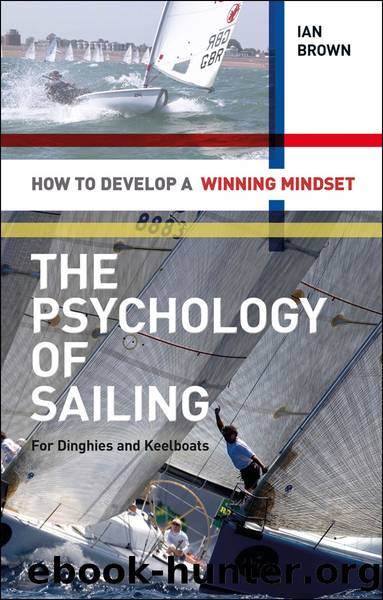The Psychology of Sailing for Dinghies and Keelboats by Ian Brown

Author:Ian Brown
Language: eng
Format: epub
Publisher: Bloomsbury Publishing
Use all of your senses to make imagery as real as possible
Attentional control â by incorporating imagery into your pre-race routines you help to ensure that you are focused on things that are controllable and task relevant rather than disruptive distractions.
Imagery then, as with most mental skills, has plenty of potential uses and can be used in many different situations or circumstances. You must however be prepared to practise it and the more you practise, the more you can find what works for you. Remember to use as many senses as you can, though taste and smell might be difficult at times. Using your senses, trying to feel emotions or moods, and recalling your thoughts all contribute to the overall vividness of the image, and the more vivid the better. However, it doesnât matter how vivid your imagery is if you canât control it. What I mean by âcontrolâ is that you have to be able to see different outcomes from what you actually experienced. For example, in the lee bow example given above, you need to have the ability to imagine yourself achieving the positive outcome having used the negative picture to identify areas for improvement. In other words you need to be able to alter and manipulate your image so that you are achieving the desired outcome. If you are unable to control the outcome then imagery may well be counter productive in that you will keep seeing or reinforcing the negative outcomes.
The final point regarding imagery concerns the perspective that you are seeing the images from. Some people see the recalled images as if they were looking through their own eyes. This is known as an internal perspective. Others see the images as if they were looking at a video recording, or through the lens of a camera. This is known as an external perspective. Neither is wrong and each seem to work equally well, but it would be a bonus if you could develop the ability to do both. Both perspectives can be used in different ways. For example, an internal perspective might help you to âfeelâ certain things better and an external perspective might be particularly useful if you wanted to see an image of yourself performing a given task and comparing it to a positive role model performing the same task. It really is a case of trying different things to see what works best and gradually building them into your mental toolbox.
Download
This site does not store any files on its server. We only index and link to content provided by other sites. Please contact the content providers to delete copyright contents if any and email us, we'll remove relevant links or contents immediately.
The River by Peter Heller(2258)
Breath by James Nestor;(2231)
Sea Survival Handbook by Keith Colwell(2199)
Fatal Storm by Rob Mundle(2174)
Deep by James Nestor(2142)
Lonely Planet Australia by Lonely Planet(2034)
Iced In by Chris Turney(1959)
Discover Australia by Lonely Planet(1906)
Lonely Planet Maldives (Travel Guide) by Planet Lonely & Masters Tom(1800)
One Girl One Dream by Dekker Laura(1639)
Looking for a Ship by John McPhee(1630)
Chicken Soup for the Ocean Lover's Soul by Jack Canfield(1603)
Ten Degrees of Reckoning: The True Story of a Family's Love and the Will to Survive by Hester Rumberg(1601)
Lonely Planet Australia (Travel Guide) by Lonely Planet & Lonely Planet(1553)
South with the Sun by Lynne Cox(1542)
The Wave In Pursuit of the Rogues, Freaks and Giants of the Ocean(1507)
Diver Down by Michael Ange(1471)
Marlinspike Sailor's Arts and Crafts by Barbara Merry(1455)
The Golden Rules: 10 Steps to World-Class Excellence in Your Life and Work by Bob Bowman & Charles Butler(1432)
